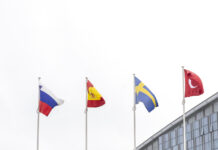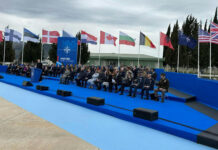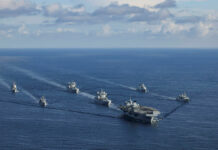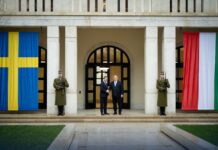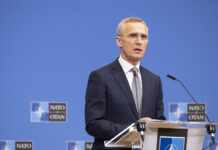Having proclaimed “360-degree defence”, NATO paid special attention to its eastern flank,
where the construction of a new defensive line has begun.
The situation on NATO’s eastern flank was gradually becoming a crisis, eventually erupting in a full-scale Russian invasion of Ukraine, which the Kremlin branded a “special military operation” in order not to associate it with an actual war for its Russian audiences, and also to have more room for manoeuvre depending on developments. For example, without naming it a ‘war’ and failing to capture Kyiv in the first weeks of the invasion, Moscow announced the “second stage of the operation”, focusing its efforts on trying to grab the entire Luhansk and Donetsk regions. However, this in no way diminishes the challenges NATO is facing, since the so-called Union State is already intending to deploy Russian tactical nuclear weapons on the territory of Belarus, while Alexander Lukashenka has repeatedly claimed that NATO, under the guise of exercises, is plotting to attack Russia via Ukraine and Belarus. Accordingly, in this situation, NATO is also facing a threat coming from Belarus, whose territory and airspace are at the full disposal of Russian troops.
NATO is already building up its presence in Eastern Europe. The existing units numbering up to 2,000 troops have been reinforced in Poland, Latvia, Lithuania, and Estonia. These represent the NATO allies bordering Russia and Belarus, where the risk of escalation and provocations is deemed the highest. That is especially the case given the Belarusian military exercise being conducted close to Polish borders and the recent crisis around transit restrictions through Lithuania to Kaliningrad. New NATO units have also been set up in Romania, Hungary, Slovakia, and Bulgaria. There are now 100,000 US troops currently stationed in Europe, 40,000 of which are under direct NATO command. However, the nations on the NATO eastern flank are now mulling the need to increase the number and deployment periods of the Alliance’s multinational forces.
The Madrid Summit
The NATO Summit in Madrid held in June 2022 was largely devoted to the response to the Russian threat. The Allies discussed issues related to increasing their deterrence and defence capabilities in the long term, strengthening partnerships, adapting to the emerging threats and challenges, ensuring transatlantic unity, and further support for Ukraine. All these aspects are reflected in the Alliance’s newly-adopted Strategic Concept for the next decade. It defines the Russian Federation as a serious and immediate threat to NATO, while China is seen as a challenge to NATO interests and values.
Having proclaimed “360-degree defence”, NATO paid special attention to its eastern flank, where the construction of a new defensive line has begun. As part of this development, the following steps are due to be taken in the near future. The headquarters of the 5th Army Corps of the US Armed Forces is being permanently deployed to Poland, two F-35 squadrons will be relocated to the UK, air defences will be strengthened in Italy and Germany, and a brigade numbering up to 3,000 military personnel and 2,000 civilian staffers will be stationed in Romania on a rotational basis. Also, two additional destroyers will be relocated to the Rota naval base in Spain. However, these are not the only steps agreed to strengthen NATO’s defensive positions in Europe. The Alliance will work on improving its operational capabilities, namely, accelerating the deployment of equipment, optimising logistics, strengthening air defences, and enhancing defence planning. The number of spearhead forces will be increased from 40,000 to 300,000.
The defence ministers of Estonia and Latvia have signed a protocol of intent at the Madrid Summit as a basis for joint procurement of air defence systems. And this is besides the fact that Spain has recently deployed additional air defence systems to Latvia. The war in Ukraine has shown that a missile shield must be as effective as possible, especially given the small size of the Baltic States. By the way, it is precisely the size of Latvia, Lithuania, and Estonia that dictates the need for them to further work out a more effective collective defence system capable of repelling Russia. As Estonian Prime Minister Kaja Kallas put it, in the event of a full-scale Russian invasion, Estonia would be “wiped off the map” if the existing NATO strategy remained in place. In the statement, made ahead of the Madrid Summit, the Estonian leader implied the size of Ukraine and the depth of Russian penetration there. According to the NATO strategy for the defence of the Baltic States at that time, the Allies planned to arrive with reinforcements following an actual invasion and liberate these territories within 180 days. However, when the whole world saw the atrocities that the Russian soldiers committed in the occupied Ukrainian settlements, it became clear that the very assumption of the seizure of any territories of NATO member countries must be off the table, since this would mean filtrations, repression, and killings of the local population. Accordingly, the increased presence of NATO units in those countries bordering Russia and Belarus seems more logical now.
Finland and Sweden Joining NATO
After Russia’s full-scale onslaught on Ukraine, Finland and Sweden unexpectedly began the process of acceding to NATO, thus leaving behind their neutrality policies. These two nations were already NATO partners, conducting multiple joint military exercises with the Allies. However, Finland shares a 1,300 km border with Russia, so Vladimir Putin has found himself entangled in his own propaganda. Having started a war under the guise of a “special operation” in Ukraine, allegedly in order to prevent NATO from approaching its borders through Ukraine’s entry into the Alliance, Russia will apparently have new NATO allies on its borders anyway – up in the north. And now the Russians will have to further strengthen their northern borders. Considering that the majority of capable Russian army units are fighting in Ukraine, the Kremlin has so far resorted to their standard practices of threatening to deploy tactical nuclear weapons in the northern regions as a response to the deployment of NATO bases in Finland and Sweden.
However, Finland and Sweden pursued their course towards joining NATO. It has become clear to decision-makers in the West that the Kremlin takes into account other country’s interests only when that country has a strong army in place. The Madrid Summit has approved a historic decision on NATO expansion as Finland and Sweden were officially invited to become NATO. The approval of their applications was initially in limbo due to the position of Turkey, which refused to give its green light due to the restriction by Sweden and Finland of arms exports to Turkey and their support for organisations that Ankara categorises as terrorist. However, as a result of negotiations between the countries involved, a tripartite Memorandum was signed on resolving the “legitimate issues” of Turkey and continuing Finland and Sweden’s path to join NATO.
The accession of Finland and Sweden to NATO is beneficial for the Alliance as their armed forces already meet NATO standards. For example, the Finns have one of the best military training systems in Europe, as well as a powerful air force and navy. After the collapse of the USSR, Finland’s leaders never reduced the country’s military potential and neither did they abandon the military draft to bolster their defence forces. As a result, an army of about 34,000 servicemen is being formed in the country, of which 22,000 are conscripts. However, in case of any military threat, mobilisation of reservists will allow increasing the army’s size to about 340,000 military personnel. In Sweden, too, conscription into the armed forces has resumed as the Swedes increase the size of their armed forces. In the event of a military threat, they intend to boost the number from the existing 55,000 to 80,000 in 2025, and to nearly 100,000 by 2030.
In addition to size, the armies of Finland and Sweden are high-tech, and systematically engaged in the acquisition of new weapons. In 2012, the Finnish Air Force signed a contract with Lockheed Martin for the supply of AGM-158 JASSM high-precision air-to-ground missiles for the F-18C/D HORNET aircraft; in 2014, US-made multiple launch rocket systems and 100 LEOPARD 2A6 main battle tanks were purchased from the Netherlands; and in 2017, 155-mm K9 howitzers were bought from South Korea. Finland has one of the most powerful artillery forces in Western Europe, consisting of about 1,500 units of various systems. As the war in Ukraine has proven, in the conditions of large-scale hostilities, artillery remains an important element for offensive operations and deterrence.
Finland is also modernising its naval fleet and updating its combat aviation. In particular, the country planned to purchase 64 modern fifth-generation F-35A LIGHTNING II multifunctional fighters, while today, the Finns operate 64 McDonnell Douglas F/A-18 HORNET fighters.
Sweden has also been engaged in the purchase of modern weapons systems to strengthen its armed forces. In 2021, Lockheed Martin launched deliveries of the first batch of PATRIOT Advanced Capability-3 (PAC-3) Missile Segment Enhancement (MSE) anti-aircraft guided missiles for the earlier purchased PATRIOT systems.
In general, Finland and Sweden’s accession to NATO means a significant strengthening of the northern borders of the Alliance. NATO will also improve its ability to control the airspace in the North of Europe and the Arctic. Moreover, due to their geographic position, the armed forces of these countries have gained experience in operating in the Arctic, which is also important for NATO. The balance in the Baltics will also change significantly, which will boost the defensive capabilities of Latvia, Lithuania, and Estonia. Russia’s capabilities in the Baltic Sea will also be sharply limited. In the event of any escalation, Russia’s Kaliningrad, home to the Baltic Fleet’s naval base, could be effectively blocked by NATO forces. The Swedish Armed Forces are also strengthening their presence on the Island of Gotland. In 2016, the Swedish military command, for the first time in 11 years, started talking about the return of its troops to the island, and since early 2022, security measures have been strengthened there due to increased Russian military activity.
Security of Eastern Europe
Once Finland and Sweden complete their accession to NATO and the northern borders are strengthened, the Alliance’s main focus will be on building up effective defence capabilities on its eastern flank and supporting the allies in countering Russian aggression. Here we should recall the events of December 2021, which preceded the start of the large-scale war between Russia and Ukraine. In December, the Russian Foreign Ministry published draft agreements with the US and NATO on security guarantees for Russia. Among other things, the Russian side wanted the United States to abandon any further deployment of military bases in post-Soviet nations and the termination of military cooperation with them. Russia also sought a halt to NATO’s further eastward expansion and a ban on any post-Soviet country from joining the Alliance. Besides, Russia wanted a renunciation of NATO’s military activity in Ukraine, Eastern Europe, Transcaucasia, and Central Asia, and non-deployment of NATO military and weapons outside the countries where they had been stationed in May 1997, that is, before the accession of Eastern European nations to the Alliance – except for “exceptional cases.” As the Russian Foreign Ministry later stated, NATO rejected the very possibility of a discussion of these matters. This is not surprising because certain requirements contradicted the fundamental principles of the Alliance, such as its open door policy.
The Russian demands were penned in the spirit of the classic Russian propaganda narratives, claiming that NATO was a threat to the Russian Federation, as the Alliance was deemed to be creeping toward Russia’s borders. And this is despite the fact that NATO is based on defensive principles, that is, collective defence, rather than any offensive action. However, Russian demands hinted at their willingness to restore the USSR in the context of influencing countries that were once members of the Warsaw Pact, formed by the Soviet Union after World War 2 as a counterweight to NATO. Incidentally, now the Russian Army is actively using Soviet paraphernalia during the occupation of settlements in the east and south of Ukraine, which only confirms the desire of the Russians to restore the USSR in a new form. This, in turn, further confirms that in the long term, the Russian leadership is focused on more than just Ukraine.
NATO and Partners in Eastern Europe
NATO Allies have realised that such a threat exists, which was confirmed during the Madrid Summit. The Allies recognised the war that Russia is waging against Ukraine as the cause of the greatest security crisis in Europe since World War 2. NATO supported Ukraine’s right to self-defence and to choose its own security system. The Alliance has once again confirmed the political and practical support to Ukraine by forming a strengthened comprehensive Assistance Package, which includes supplies of non-lethal defence equipment, the improvement of Ukrainian cyber defences, modernisation of the country’s security and defence sector, and transition to long-term interoperability. In particular, such assistance should include secure communications systems, supplies of medical equipment, body armour, demining equipment, means of protection against chemical and biological weapons, and systems for combating drones. NATO has also assured Ukraine of support for its post-war reconstruction and reforms. According to Spanish Prime Minister Pedro Sanchez, NATO is ready to provide various kinds of support to Ukraine until the last Russian soldier pulls from its territory.
Since NATO defence ministers have identified the need to strengthen the Alliance’s eastern flank, that is, the territory from the Baltic Sea to the Black Sea, Ukraine, as an ally, will play a crucial role to this end, given its geographical position. So far, NATO has realised the need for a radically quicker response to a crisis (60 days for the deployment of a rapid response force is clearly not enough, since the Russian troops tried to achieve their goals in a short time using the stun element), but in practice, this is difficult to achieve. Logistical problems remain, with an insufficient number of ports, trains, and bridges for a quicker shipment of heavy armoured vehicles from the United States and Central Europe to Eastern Europe. In such conditions, the Alliance should be interested in Ukraine moving in the long-term from Soviet-era weapons to modern NATO arms, and reach maximum interoperability with NATO armies. This will significantly increase the security and defence capabilities in Eastern Europe. In fact, with the ongoing arms supplies, the process has already kicked off. Since the full-scale invasion of Russia in 2022, NATO and allies have provided Ukraine with support at unprecedented levels.
It should be noted that NATO as an organisation does not supply weapons to Ukraine in order, as NATO Secretary General Jens Stoltenberg put it, to prevent further escalation and a direct clash between NATO and Russia. However, such decisions on arms supplies can be made by individual allies, and coordinated with the actual needs of Ukraine, for example, within the framework of the US-initiated Ramstein negotiating platform for military support to Ukraine, which brought together at the inaugural meeting defence officials of 43 countries. In addition to this, NATO does not have any list of weapons that must not be supplied to Ukraine. Given the intensity of hostilities and the limited stocks of Soviet weapons in Ukraine, the only way for the embattled nation to survive is to switch to modern models of military equipment, including armoured vehicles and warplanes. Meanwhile, the transfer of M142 HIMARS and M270 MLR systems to Ukraine has already proven its effectiveness in destroying Russian military depots in the occupied territories, which has been confirmed by Pentagon officials. In the future, deliveries of American F-16 aircraft to Ukraine may also begin. It is already a fact that the United States will start training Ukrainian pilots to fly F-15 and F-16 fighters. The corresponding amendments to the US military budget have been approved by the US House of Representatives, which allocated US$100M to this end.
Ukraine is also interested in mastering modern air defence systems, given the need to counter regular Russian missile attacks on peaceful Ukrainian cities. Media reports claim that in the future, Ukraine wants to purchase from Germany ten IRIS-T stationary air defence systems and 100 PANZERHAUBITZE 2000 self-propelled artillery mounts. Ukrainian officials also requested the Norwegian NASAMS missile defence system, which is capable of engaging targets at a distance of over 160 km. These systems may be included in the next package of heavy weapons that the United States will hand over to Ukraine.
Thus, the process of transition of the Ukrainian Armed Forces to NATO weapons and standards has already begun; this has laid the foundation for Ukraine’s participation in the system of collective security in Eastern Europe in the post-war period. Its army will be fully compatible with the armies of NATO allies. Moreover, the deployment of an effective missile defence system in Ukraine will mean additional security for Europe, given the regular anti-Western statements coming from Moscow and Minsk.







